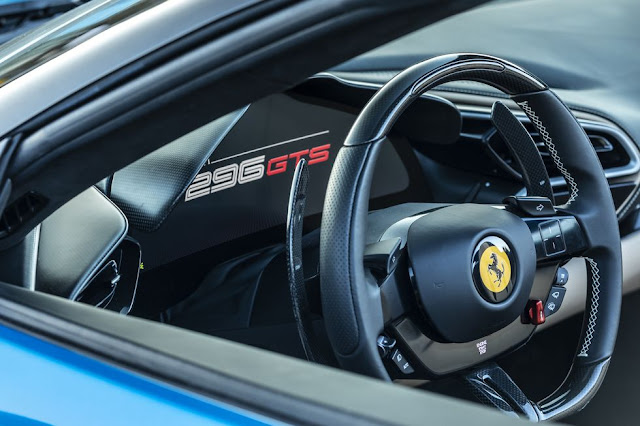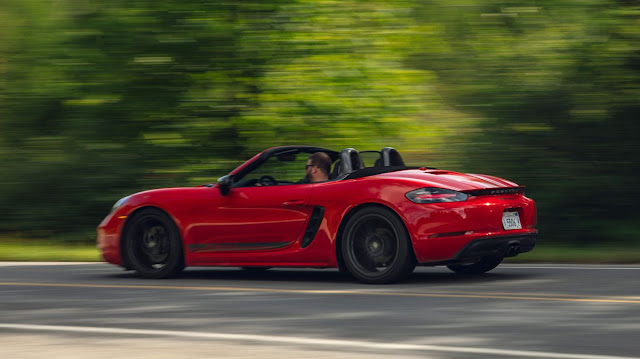2023 Ferrari 296GTS Breaks the V-8 Bloodline
Don't worry—between the e-motor and the fact that it's still a Ferrari, the 296GTS won't leave anyone wanting.
It's tough enough when inflation and feature creep give us $40,000 Priuses and $80,000 pickups. But before we spray champagne praise all over the Ferrari 296GTS convertible—ooh, see how that Blu Corsa paint sparkles!—a sober drip must ping off a $500,300 as-driven price, from a base of $371,139. That base figure represents a $28,934 premium over the 296GTB coupe—a sum that repays itself the minute one retracts the roof panel on a sunny autumn day or moonlit night, as we did in New York's Hudson Valley. But Ferrari is also asking nearly $45,000 more for its plug-in-hybrid V-6 convertible than its F8 Spider predecessor. You know, the supercar with the mid-engine V-8 that's been Ferrari's stock-in-trade since the 1975 308 GTB. After nearly a half-century, Ferrari's V-8 bloodline has been broken.
Yet instead of baying for blood, like Porsche 993 airheads, Ferrari fans are largely taking it in stride, or even celebrating the 296. Why? It doesn't hurt that the Ferrari is gorgeous. Coupe or convertible, the 296 design seems certain to stand the test of time. Ferrari designers say their goal was authentic Italian forms, a silhouette that appears drawn with a single pencil stroke. A compact greenhouse sits low, bobbing in impossibly wavy fenders. Compact dimensions and a 1.9-inch-shorter wheelbase (versus recent mid-engine models) amplify the simplified charm in an era of relentless bloat. There's nothing extraneous, no overcompensating wings or South Beach jewelry, or even stark color contrasts between body and trim to interrupt the flow.
Then there's the magic of electrification, which turns the V-6 Ferrari into an 819-hp superhero that even a plug-in skeptic might find hard to lob kryptonite at. Recall that the 296GTB coupe is the quickest rear-drive car C/D has ever tested, sprinting into record books with a 2.4-second blast to 60 mph and an insane 9.7-second quarter-mile at 150 mph. Beyond objective speed, Ferrari insists it can measure driving "fun" via five discrete factors, including steering response, engine sound, and brake feel. Using those metrics as goalposts, Ferrari designed the 296 to objectively be its most fun-to-drive model.
After the top's 14.0-second opening ceremony near Bear Mountain, the six-cylinder fanfare begins, set to the symmetrical firing order of a naturally aspirated Ferrari V-12. Easing through opening curves, we've got an unbroken connection between our noggins, a pair of whooshing 180,000-rpm turbos, and a patented "hot tube" exhaust resonator that channels the engine's emotion into the cabin.
Maintaining the coupe's thrilling sound when the top is raised, including a wicked trebly register as the engine ascends to 8500 rpm, required redesigning the engine bay. Pro tip from a Ferrari technician: Lowering the rear glass and raising side windows further concentrates the delightfully layered sound.
Flavio Manzoni and his design department took an entirely new company approach to chopping the GTB's roof to deliver an appreciably better GTS convertible. The folding hardtop splits into two sections above the B-pillar that fold flush over the V-6, assuring proper thermal dissipation and a smooth roof appearance. The loss of the coupe's engine-under-glass setup is the only trade-off, although the redesigned deck still makes room for a smaller tinted viewing window.
An alluring tonneau cover design mimics the aerodynamic and cooling behavior of the coupe, including zero loss of downforce when the roof is lowered. The GTS can surge to a 205-mph top speed with roof up or down. The coupe's bravura flying buttresses are still here but with sculptural extensions that smartly house the fuel filler and charging port for the lithium-ion battery. Cozied into a classic Kamm tail, inspired by the 1963 250LM, an active rear spoiler switches up the function of previous Ferrari aero tails. It rises to boost downforce rather than ease drag, adding 220 pounds of wind heft to the rear axle. Ferrari says the fancy-folding top adds 154 pounds to the 296GTB, that when equipped with lightweight Assetto Fiorano package weighed 3532 pounds on our scales. Ferrari also claims the GTS is 50 percent stiffer than the F8 Spider.
Flying through colonnades of trees, the open roof amplifies every piney smell, streak of sun, and chirp from the Michelin Pilot Sport 4S tires. As for top-down turbulence, it's not Dorothy-in-Kansas level, but there is buffeting as speeds climb toward triple digits. The cabin is a fantasy perch, from the instrument cluster's starfighter-style structural supports to an expanded passenger display screen. Like the coupe, the GTS adopts the digital interface concept first seen in the SF90. The design is striking, but the infotainment system is a stubborn collection of haptic steering-wheel controls managed exclusively through the instrument cluster. On this model, optional carbon-fiber racing seats look like Picasso sculptures. Manually adjusting the backrests via a stiff crank and a fumbling rearward reach recalls an old VW. An analog high point is the lovely cloisonné key fob, enameled in Italian flag colors and a prancing cavallino, that snugs into a console holder. But the steering wheel's haptic startup switch has all the drama of an ATM touchpad.
With its efficient hot-vee twin-turbo layout, the V-6 makes 654 horsepower, threatening the 670-hp output of a Corvette Z06's 5.5-liter V-8 that has nearly double the displacement. By itself, that might be enough. But consider the V-6 as 654 Trojan horses, with another 164 electric horses ready to spring a surprise attack. They're housed in an axial-flux AC motor between the engine and the eight-speed dual-clutch transmission. A tag-team 819 horsepower sets a new record for specific output in a production convertible. A clutch allows decoupling in hybrid operation or all-electric driving for an EPA-estimated seven miles at speeds up to 83 mph. The electric motor fills any gaps with a peak 232 pound-feet of torque, and it's also responsible for starting the V-6.
Ferrari warns us that, though the 296 is a plug-in hybrid and not an electric vehicle, you can run out of electricity as well as premium unleaded. Leave the 296 in Hybrid mode for too long, and it may drain its battery low enough—especially if you're sitting with power and accessories on—to resist a restart. The easy solution is to drive in Performance mode, one step below the maximum Qualify setting. Performance mode can fully recharge the small battery on the fly in 20 minutes or less. Speed the process by finding excuses to hammer the Herculean brakes to slurp up regenerative juice through the rear wheels. The brake-by-wire system is simply the best in the electrified game. You can stand on them like you're coming down the Mulsanne, yet they work just as well in city traffic. And the electrically assisted steering brews up that signature Ferrari blend of lightness and clarity.
The power feels, well, naturally unnatural. On Route 9W, a mini Highway 1 that clings to bluffs overlooking the Hudson River, the Ferrari blitzes a downhill chicane on the descent into West Point. Magnetorheological dampers ably suppresses pavement jitters, but the Bumpy Road setting still works best for compliance on virtually any public road.









